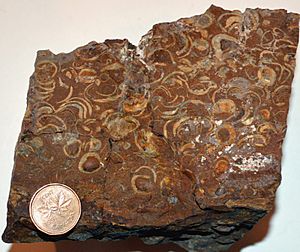Cardium Formation facts for kids
Quick facts for kids Cardium FormationStratigraphic range: Turonian to Coniacian |
|
|---|---|

Photomicrograph of drill cuttings from Cardium Formation sandstone.
|
|
| Type | Geological formation |
| Unit of | Alberta Group, Colorado Group, Smoky Group |
| Sub-units | Sturrock Member, Leyland Member, Cardinal Member, Kiska Member, Moosehound Member, Ram Member. |
| Underlies | Wapiabi Formation |
| Overlies | Blackstone Formation, Kaskapau Formation |
| Thickness | 22 metres (70 ft) to 109 metres (360 ft) |
| Lithology | |
| Primary | Sandstone |
| Other | Shale |
| Location | |
| Coordinates | 51°08′28″N 114°59′40″W / 51.14101°N 114.99446°W |
| Region | Western Alberta, and northeastern British Columbia |
| Country | |
| Type section | |
| Named for | Cardium shells |
| Named by | James Hector, 1895 |
The Cardium Formation is a special layer of rock found deep underground in western Canada. It formed a very long time ago, during the Late Cretaceous period. This was about 90 million years ago, when dinosaurs still roamed the Earth!
The formation gets its name from tiny, fossilized cockle shells that look like hearts. These shells belong to a type of clam called Cardium. A scientist named James Hector first described this rock layer in 1895 near the Bow River. Today, the Cardium Formation is important because it holds a lot of petroleum (oil) and natural gas.
Contents
What is the Cardium Formation Made Of?

The Cardium Formation is mostly made of sandstone, which is like hardened sand. It also has thick layers of shale, which is a type of soft, layered rock.
Scientists divide the Cardium Formation into smaller sections called "members." These members are different layers of sandstone and shale:
- Sturrock Member (sandstone)
- Leyland Member (shale)
- Cardinal Member (sandstone)
- Kiska Member (shale)
- Moosehound Member (shale)
- Ram Member (sandstone)
In some parts of central Alberta, the formation is known by different names. These are the Pembina River Member and the Cardium Zone.
Where is the Cardium Formation Found?
The Cardium Formation was formed during the Turonian and Coniacian ages of the Late Cretaceous period. It stretches across a huge area in western Canada. You can find it from the Canada-United States border all the way north to Dawson Creek in northeastern British Columbia.
It also extends eastward from the foothills of the Canadian Rockies into the flat plains of southern and central Alberta. In some areas, the sandstone layers change into shale. The thickness of the Cardium sandstone can be anywhere from 5 to 30 meters.
How Does it Relate to Other Rock Layers?
Because the Cardium Formation covers such a large area, it is part of different larger rock groups. These include the Alberta Group, Colorado Group, and Smoky Group.
The Cardium Formation sits underneath the Wapiabi Formation. It rests on top of the Blackstone Formation. Some parts of the Cardium Formation are also similar to the Kaskapau Formation.
Why is the Cardium Formation Important?
The Cardium Formation is very important for producing energy. Natural gas is found in this formation in the Athabasca River area and the foothills of western Alberta. Oil is also produced from it, especially in the Pembina oil field in central Alberta.
The sandstone layers in the Cardium Formation are good at storing oil and gas. Thick layers of shale above it, like the Wapiabi Formation, act like a cap, trapping the oil and gas. The black shale below, such as the Blackstone Formation, is where the oil and gas originally formed.
As of 2008, the Cardium Formation had a lot of oil and gas. About 305 million cubic meters of oil could be recovered, and most of it has already been taken out. There were also large amounts of natural gas.
New Ways to Get Oil
In 2009, drilling for oil in the Cardium Formation became popular again. This was because of new technologies. These include horizontal drilling, where drills go sideways through the rock, and multi-stage fracturing. Fracturing is a process where water and sand are pumped into the rock to create tiny cracks. This helps the oil and gas flow out more easily.
These new methods made it possible to get much more oil from the ground. Even in the old Pembina oil field, which had been producing for decades, these technologies brought new life to the area.
Hydraulic Fracturing in Canada
Hydraulic fracturing (often called "fracking") has been used a lot in Alberta since the late 1970s. This method is now used to develop oil and gas in many formations across Canada. These include the Cardium, Duvernay, Montney, and Viking formations in Alberta. It's also used in the Bakken in Saskatchewan and the Horn River in British Columbia.
Many oil and gas companies are working in the Cardium Formation. They are using these new recovery techniques to get more oil and gas out of the ground.

